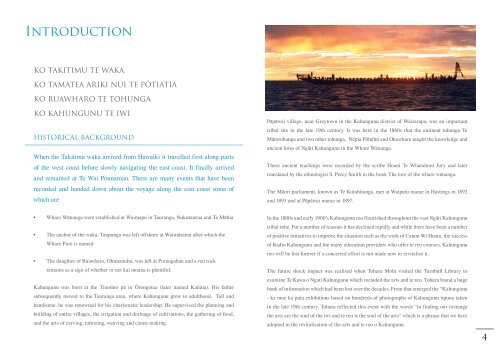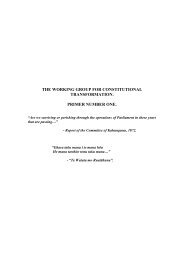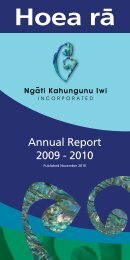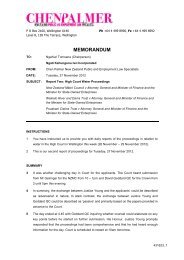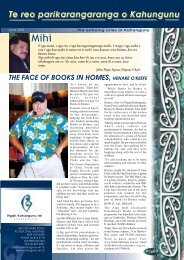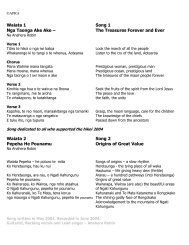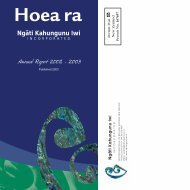StRAtEGic PlAn FoR ThE REVitAlisAtion OF TE REo O NGÃti ...
StRAtEGic PlAn FoR ThE REVitAlisAtion OF TE REo O NGÃti ...
StRAtEGic PlAn FoR ThE REVitAlisAtion OF TE REo O NGÃti ...
You also want an ePaper? Increase the reach of your titles
YUMPU automatically turns print PDFs into web optimized ePapers that Google loves.
IntroductionKO TAKITIMU <strong>TE</strong> WAKAKO TAMA<strong>TE</strong>A ARIKI NUI <strong>TE</strong> PŌTIATIAKO RUAWHARO <strong>TE</strong> TOHUNGAKO KAHUNGUNU <strong>TE</strong> IWIHISTORICAL BACKGROUNDWhen the Takitimu waka arrived from Hawaiki it travelled first along partsof the west coast before slowly navigating the east coast. It finally arrivedand remained at Te Wai Pounamau. There are many events that have beenrecorded and handed down about the voyage along the east coast some ofwhich arePāpāwai village, near Greytown in the Kahungunu district of Wairarapa, was an importanttribal site in the late 19th century. It was here in the 1860s that the eminent tohunga TeMātorohanga and two other tohunga, Nēpia Pōhūhū and Okawhare taught the knowledge andancient lores of Ngāti Kahungunu in the Whare Wānanga.These ancient teachings were recorded by the scribe Hoani Te Whatahoro Jury and latertranslated by the ethnologist S. Percy Smith in the book The lore of the whare wānanga.The Māori parliament, known as Te Kotahitanga, met at Waipatu marae in Hastings in 1892and 1893 and at Pāpāwai marae in 1897.• Whare Wānanga were established at Waimapu in Tauranga, Nukutaurua and Te Māhia• The anchor of the waka, Taupunga was left offshore at Waimārama after which theWhare Puni is named• The daughter of Ruawharo, Ohinemuhu, was left at Porangahau and a red rockremains as a sign of whether or not kai moana is plentiful.Kahungunu was born at the Tinotino pā in Ōrongotea (later named Kaitāia). His fathersubsequently moved to the Tauranga area, where Kahungunu grew to adulthood. Tall andhandsome, he was renowned for his charismatic leadership. He supervised the planning andbuilding of entire villages, the irrigation and drainage of cultivations, the gathering of food,and the arts of carving, tattooing, weaving and canoe making.In the 1800s and early 1900’s Kahungunu reo flourished throughout the vast Ngāti Kahungunutribal rohe. For a number of reasons it has declined rapidly and while there have been a numberof positive initiatives to improve the situation such as the work of Canon Wi Huata, the successof Radio Kahungunu and the many education providers who offer te reo courses, Kahungunureo will be lost forever if a concerted effort is not made now to revitalise it.The future shock impact was realised when Tohara Mohi visited the Turnbull Library toexamine Te Kawa o Ngati Kahungunu which included the arts and te reo. Tohara found a hugebank of information which had been lost over the decades. From that emerged the “Kahungunu- ka moe ka puta exhibitions based on hundreds of photographs of Kahungunu tipuna takenin the late 19th century. Tohara reflected this event with the words “in finding our iwitangathe arts are the soul of the iwi and te reo is the soul of the arts” which is a phrase that we haveadopted in the revitalisation of the arts and te reo o Kahungunu.4


